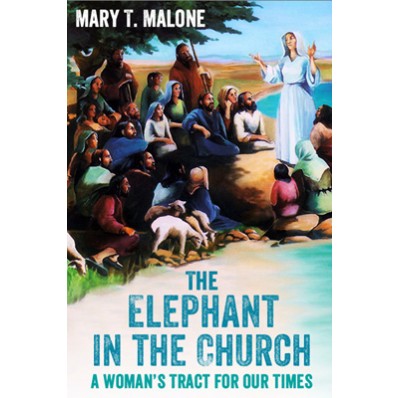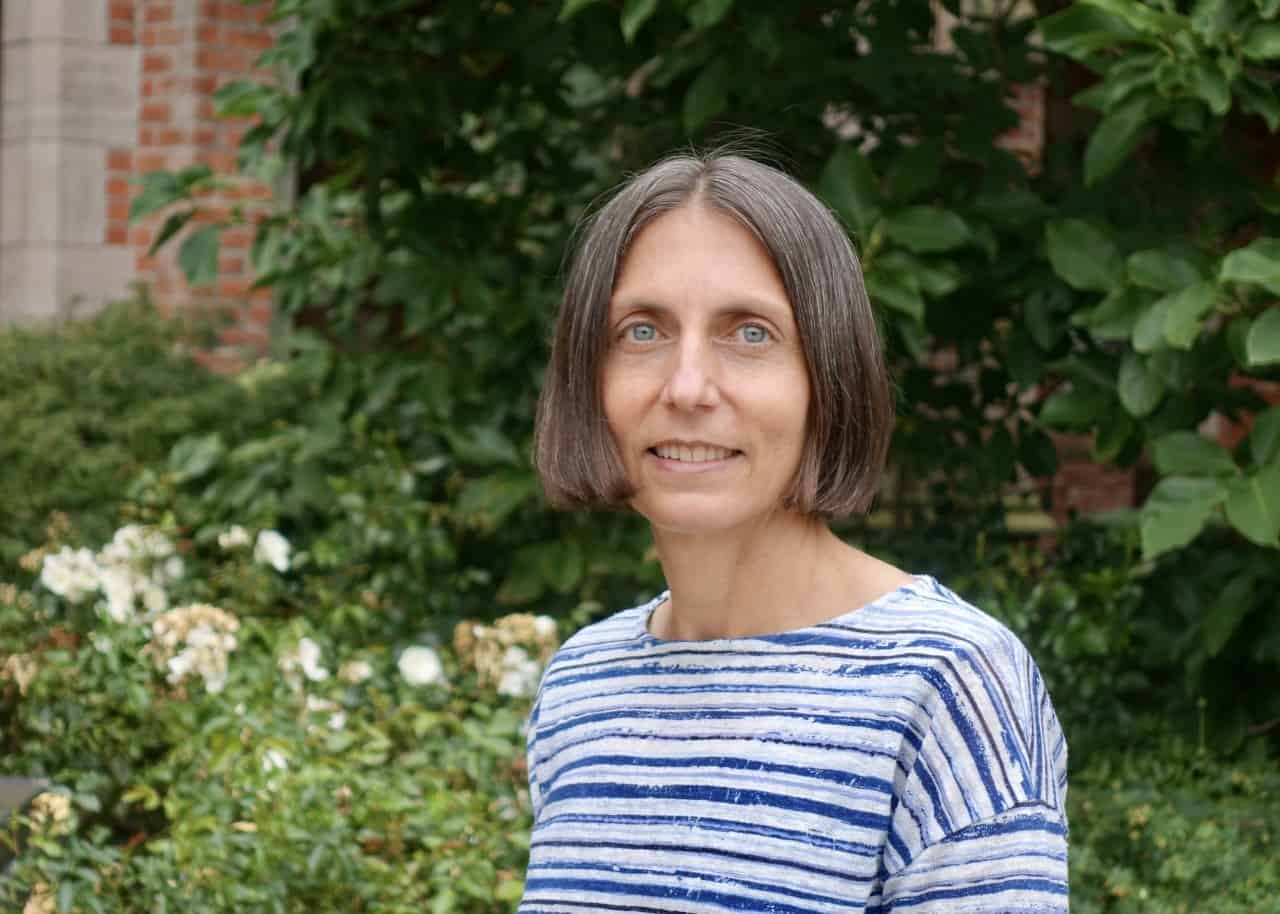The Elephant in the Church: A Woman’s Tract for Our Times (Columba 2014), the latest book by Mary T. Malone, is a passionately-argued, historically-grounded plea for women to have equal voices and positions in the Catholic Church.
Malone retired home to Ireland in 1997 after teaching almost 40 years in Canada in Toronto’s St Augustine Seminary, and the University of St Jerome’s, the Catholic College on the campus of the University of Waterloo. She is previously the author of a trilogy onWomen and Christianity (2000,  2001, 2003) and Praying with the Women Mystics (2006), all published by Columba.
2001, 2003) and Praying with the Women Mystics (2006), all published by Columba.
Malone argues that women, and their exclusion, are the ‘elephant in the room’ when it comes to discussions of renewal and reform in the Catholic Church.
The male-dominated hierarchy just don’t want to talk about women or listen to their perspectives. Women’s exclusion is an issue that won’t be solved simply by allowing the ordination of women to the priesthood, an office which Malone sees as a ‘male construct’. For her, change must go much deeper than that. As she writes (xii):
‘Women are still the permanently silenced members of the Roman Catholic Church, nothing they think or say is of interest when it comes to formulating teaching, or revising the public prayer of the Church. But the Good News has penetrated the imaginations of people, and the open horizons offered by Jesus continue to inspire people to move beyond the imposed spiritual and theological restrictions.’
Setting herself the task of pushing her readers beyond these restrictions, The Elephant in the Church chronicles, ‘the lives and teaching of women throughout the whole span of Christianity … in the hope that, as women and men Christians, our joint insights, historical and contemporary, may help to renew the church we love’ (p. xiii).
Malone devotes her first chapter to the distinction between a ‘Catholic Woman’ and a ‘Woman Catholic.’
For her, the Catholic Woman leads ‘a private, non-participatory Christian life,’ confined by men to her roles in the home. But a Woman Catholic ‘brings the whole of her bodily being to her faith, and worships the God in whose image she is made, as a woman’ (p. 2). The rest of the book provides examples of women doing just that, from the time of Jesus to the present.
These include chapters on:
- ‘Women and Scripture’, where she considers passages from the creation stories to the gospels to Paul’s letters;
- ‘Women and Monasticism in the Fourth Century’, where she describes a period where ‘communities of virgins, leading their own lives of asceticism and prayer, under their own leadership … really seemed to have scared the Church’ (p. 47);
- ‘The Medieval Women Mystics’, including Hildegarde of Bingen;
- ‘The Beguines’, including Mechtilde of Magdeburg and Marguerite Porete;
- ‘Lone Mystics’, including Julian of Norwich and Catherine of Siena;
- ‘Women and Missions’, including Teresa of Avila and the Carmelite Reform, and Jane de Chantal and Louise de Marillac
There are further chapters on:
- ‘The Marian Influence,’ where she argues that ‘devotion to Mary has delayed strenuously, rather than promoted, any efforts at promoting respect for the dignity and rights of women in the Catholic Church’ (p. 145);
- ‘The Sixties: Vatican II and Feminism,’ which traces the development of Christian feminism and details how women increasingly began acting outside the boundaries of the hierarchical Church; and
- ‘The Once and Future Church,’ where she reiterates her argument that the Church needs women’s contributions to survive and thrive.
All of the chapters provide an education about ‘Woman Christianity’s’ greatest thinkers and actors, whose contributions have not been fully recognised largely because male leaders of the church actively silenced them. Indeed, a consistent theme throughout the book is how women often developed innovative theologies and practices, only to have men take the credit for them, or try to make sure their words did not get out.
Malone handles the vast scope of her material and the time span covered with aplomb, deftly telling the stories of these Women Christian’s lives and highlighting their key insights. In some of the chapters on the mystics, she expresses their ideas in her own poetry, introducing another welcome form of communication.
I learned a lot from this book, as my Christian education has been (like that of many people I suspect), devoid of much deep engagement with women. (Having said that, I do remember studying Julian of Norwich, Hildegarde of Bingen and Catherine of Siena in my Development of Western Civilisation course at Providence College; and I have learned much about the Beguines from my friends Janet Morris and Ethel White.)
To close, I want to share two passages from the book that have stuck with me, because they made me think in a different way:
On Mary of Magdala (p. 27):
‘It is obvious from the biblical testimony that Mary was the leader of the women disciples, as Peter was the leader of the men. It is also obvious that when the male disciples abandoned Jesus at the end, the women, led by Mary of Magdala, remained faithful. It is also clear that the women seemed closer to the mind of Jesus about his role and message than the men were. Finally, it is clear that Mary and her companions were the first witnesses of the Resurrection, the first proclaimers and preachers of the Christian message, and the ones who went to retrieve the men after the Resurrection, thus laying the foundation stones of Christianity. In other words, it is not difficult to call Mary of Magdala and her companions the true founders of the Christian Church.
On the contrast between Marian Devotion and the position of women in the Catholic Church (p. 147):
‘… in the Roman Catholic Church there is not one single theological reflection by a woman on the experience of conceiving, carrying, bearing or nourishing a child. No male theologian can do this. The one example of giving birth that has been appropriated by the Roman Catholic Church is the doctrinally taught, miraculous, virginal birth of Jesus by Mary, who was herself, as is also doctrinally taught, miraculously and immaculately conceived. Thus all female carnality has been removed from Church doctrine. Women’s lives can never be a source for the doing of theology. The only life available for this is the life of the virgin mother, who can never be a model for the ordinary women, who experiences intercourse, sexual orgasm, pregnancy, birthing, and breast-feeding. None of this is a resource for theology, even though Pope Francis welcomes breast-feeding women to his allocutions. As we saw, the medieval women mystics were very much aware of this and found the need to address their God as Mother. But even the elevation of four women to the status of Doctor of the Church, all of them virginal and long-dead nuns, has not altered this situation.’
In closing, The Elephant in the Church has all the ingredients of a book that can benefit Christians from a variety of traditions: it is clearly written, informative and provocative.
Malone has done us all a service by bringing these Women Christian’s voices to our attention. Now it is up to all of us to listen.
(This review first appeared on www.gladysganiel.com)

Gladys is a Professor of Sociology at Queen’s University Belfast and a member of the Royal Irish Academy.
She is also a runner who has represented Ireland and Northern Ireland. She blogs on religion and politics at gladysganiel.com
Discover more from Slugger O'Toole
Subscribe to get the latest posts to your email.